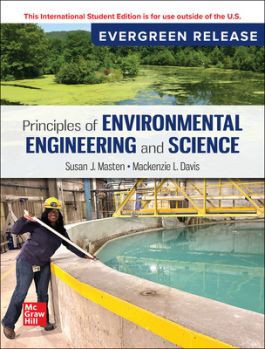Principles of Environmental Engineering & Science: 2024 Release ISE
1264526377
·
9781264526376
Principles of Environmental Engineering is intended for a course in introductory environmental engineering for sophomore- or junior-level students. This text provides a background in fundamental science and engineering principles of environmental eng…
Read More
After you purchase your eBook, you will need to download VitalSource Bookshelf, a free app. Then login or create an account and enter the code from your order confirmation email to access your eBook.
- Note: the eBook does not include access to Connect
- Access the eBook anytime, anywhere: online or offline
- Create notes, flashcards and make annotations while you study
- Full searchable content: quickly find the answers you are looking for
1 Introduction
2 Chemistry
3 Biology
4 Materials and Energy Balances
5 Ecosystems
6 Risk Perception, Assessment and Management
7 Hydrology
8 Sustainability
9 Water Quality Management
10 Water Treatment
11 Wastewater Treatment
12 Air Pollution
13 Solid Waste Engineering
14 Hazardous Waste Management
15 Noise Pollution
16 Ionizing Radiation
2 Chemistry
3 Biology
4 Materials and Energy Balances
5 Ecosystems
6 Risk Perception, Assessment and Management
7 Hydrology
8 Sustainability
9 Water Quality Management
10 Water Treatment
11 Wastewater Treatment
12 Air Pollution
13 Solid Waste Engineering
14 Hazardous Waste Management
15 Noise Pollution
16 Ionizing Radiation
Principles of Environmental Engineering is intended for a course in introductory environmental engineering for sophomore- or junior-level students. This text provides a background in fundamental science and engineering principles of environmental engineering for students who may or may not become environmental engineers. Principles places more emphasis on scientific principles, ethics, and safety, and focuses less on engineering design. The text exposes students to a broad range of environmental topics—including risk management, water quality and treatment, air pollution, hazardous waste, solid waste, and ionizing radiation as well as discussion of relevant regulations and practices.
The book also uses mass and energy balance as a tool for understanding environmental processes and solving environmental engineering problems.

